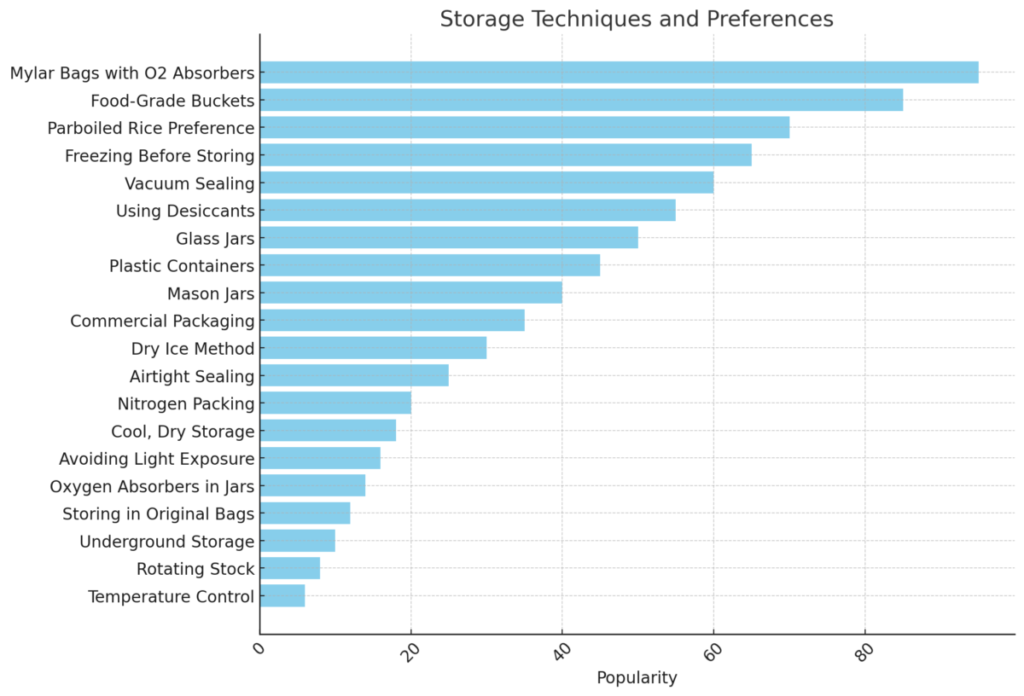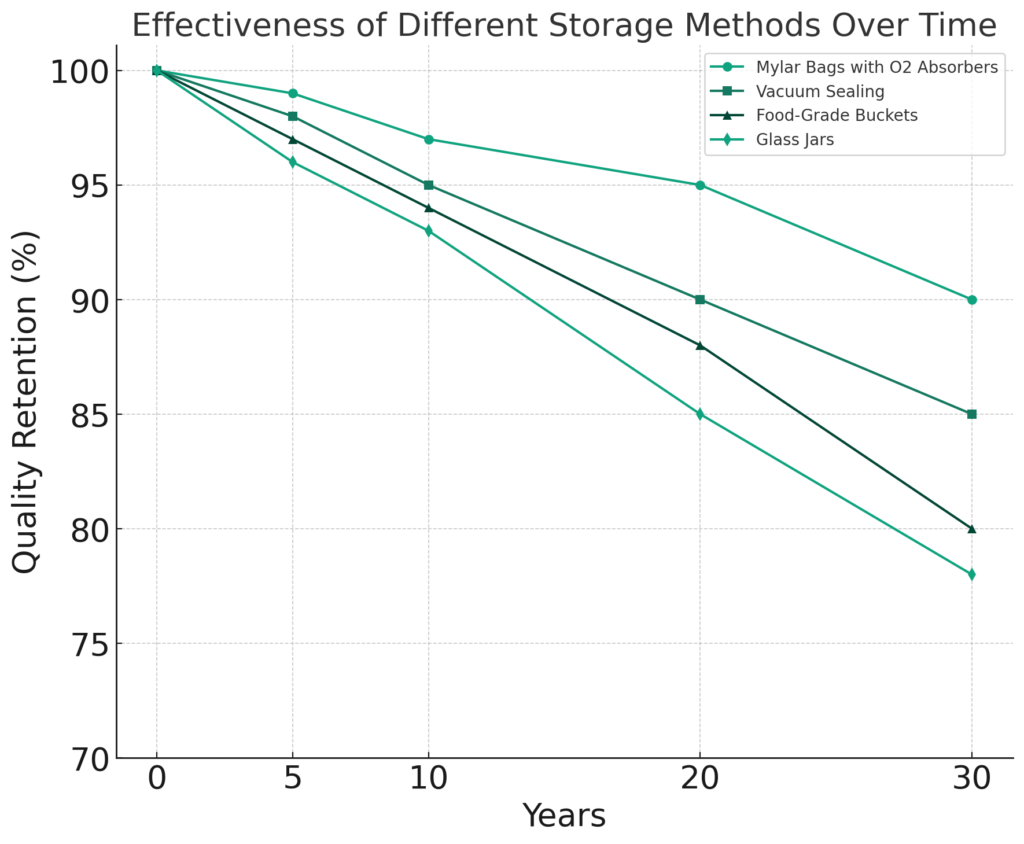Rice is a staple food that every prepper should have in their long-term food storage. But how do you ensure it stays fresh and edible for years, or even decades? This comprehensive guide on “rice long term storage” will reveal the answer.
| Container Type | Advantages | Disadvantages |
|---|---|---|
| Plastic Buckets | Durable, stackable, reusable | Bulky, may require additional liners |
| Mylar Bags | Lightweight, compact, easy to seal | Susceptible to punctures, limited reusability |
Whether you’re stocking up for emergencies or simply want a reliable food source, this article will equip you with the knowledge and strategies to keep your rice fresh and delicious for the long haul as a part of complete food and water storage.
Rice is a staple food for billions of people worldwide, and its importance in emergency preparedness and long-term food storage cannot be overstated. Whether you’re prepping for potential disasters or simply want to maintain a well-stocked pantry, storing rice long term is a crucial skill to master.
In this comprehensive guide, we’ll explore the best practices, techniques, and considerations for preserving rice for extended periods, ensuring you have a reliable food source in times of need.
Table of Contents
Reddit Weighs In: Mylar Bags a Clear Winner
We read through 193 comments in 3 Reddit threads in r/preppers on Rice and Long Term Rice Storage:
- /r/preppers: White Rice – The Best Long Term Food Item
- /r/preppers: How To Store Rice Long-Term (Guide)
- /r/preppers: Rice Storage-Long Term
Here is the community consensus:

Consensus
The prepper community has a strong consensus on the importance of effective long-term rice storage strategies, emphasizing the necessity of preserving rice’s nutritional value, flavor, and safety over extended periods.


The “Effectiveness of Different Storage Methods Over Time” graph illustrates that Mylar bags with O2 absorbers are the most effective method for preserving rice quality over time, outperforming vacuum sealing, food-grade buckets, and glass jars across a span of up to 30 years.
The preferred method among preppers is the use of Mylar bags coupled with oxygen absorbers, stored within food-grade buckets. This combination is lauded for its ability to significantly extend the shelf life of rice, with many suggesting it can keep rice viable for 30 years or more under optimal conditions.
Parboiled rice emerges as a specific preference for those looking to balance nutritional content with longevity, offering a middle ground between the extended shelf life of white rice and the nutritional advantages of brown rice, which is generally avoided due to its shorter shelf life caused by oil content that can go rancid.
Alternative Methods
Preppers also highlight the importance of freezing rice prior to storage to eliminate pests and their eggs, a step seen as crucial to maintaining the rice’s integrity.
Moreover, the community advises against storing rice in conditions that could lead to moisture exposure or temperature fluctuations, suggesting cool, dry, and dark spaces as ideal.
In essence, the prepper community’s approach to rice storage is marked by a meticulous attention to detail, prioritizing methods that ensure longevity, prevent infestation, and retain the rice’s usability for as long as possible.
Understanding Rice and Its Shelf Life
Before diving into the specifics of long term rice storage, it’s essential to understand the factors that affect the shelf life of this versatile grain.
Rice comes in various forms, each with its own unique characteristics and storage requirements.
Moisture Content
Maintaining low moisture content is crucial for long term rice storage. Rice with higher moisture levels is more susceptible to mold, insect infestations, and spoilage. The ideal moisture content for long-term storage varies depending on the type of rice, but generally, it should be below 12-14%.
| Rice Type | Ideal Moisture Content |
|---|---|
| White Rice | 12-14% |
| Brown Rice | 10-12% |
| Wild Rice | 8-10% |
Oxygen Exposure
Oxygen exposure is another factor that can significantly impact the quality and shelf life of stored rice. Oxygen promotes the oxidation of fats and oils present in rice, leading to rancidity and a loss of flavor and nutritional value. Minimizing oxygen exposure is key to preserving the freshness and taste of your rice stockpile.
Preparing Rice for Long-Term Storage
To ensure your rice stays fresh and edible for years to come, proper preparation is essential. Here are the steps to follow:
Selecting the Right Rice Variety
Not all rice varieties are created equal when it comes to long term storage. Consider the following factors when choosing a rice variety:
- Whole grain rice (brown, red, or black rice) has a shorter shelf life than white rice due to its higher oil content.
- White rice, particularly long-grain varieties like jasmine or basmati, tends to have a longer shelf life when stored properly.
Proper Cleaning and Drying
Before storing your rice, it’s crucial to thoroughly clean and dry it to remove any impurities, insects, or excess moisture. Here’s how:
- Inspect the rice visually and remove any debris, stones, or discolored grains.
- Spread the rice out on a clean, dry surface and let it air dry completely. You can also use a food dehydrator or low oven temperature to speed up the drying process, as outlined in our guide on drying and dehydration methods.
- Once completely dry, package the rice immediately to prevent moisture absorption.
Packaging and Sealing
Proper packaging and sealing are essential for long term rice storage. Here are some recommended methods:
- Use food-grade plastic buckets or mylar bags specifically designed for long-term storage.
- Remove as much air as possible from the containers before sealing them. Vacuum sealing is an effective method for this.
- Consider adding oxygen absorbers to the containers to further reduce oxygen exposure.
- Seal the containers tightly to prevent moisture and pests from entering.
Optimal Storage Conditions
Even with proper preparation, storing rice in suboptimal conditions can significantly reduce its shelf life.
Here are the key considerations for creating an ideal storage environment:
Temperature and Humidity Control
| Temperature Range | Recommended Humidity Level |
|---|---|
| 40°F – 70°F | Below 15% |
| 70°F – 100°F | Below 10% |
- Maintain a cool, dry environment for your stored rice. Extreme temperatures and high humidity can promote spoilage and insect activity. Temperature control in food storage is essential.
- Use a dehumidifier or desiccant packs to control humidity levels if necessary.
- Monitor temperature and humidity regularly, and make adjustments as needed.
Pest Control
Pests like insects and rodents can quickly infest and ruin your rice stockpile. Take these preventive measures:
- Store rice in sealed, pest-proof containers.
- Inspect your storage area regularly for signs of pests.
- Use natural pest control methods like diatomaceous earth or food-grade desiccants if necessary. Learn how to prevent pest infestations in dry goods storage.
Rotation and Monitoring
- Practice the first-in, first-out (FIFO) method to ensure your oldest rice gets used first. This guide explains the FIFO method for effective food rotation.
- Periodically inspect your stored rice for signs of spoilage, such as odors, discoloration, or insect activity.
- Keep detailed records of when you stored each batch of rice and its expected shelf life.
Long-Term Storage Methods
While there are various methods for long term rice storage, some techniques have proven to be more effective than others. Here are some popular options:
Airtight Containers
Airtight containers, such as food-grade plastic buckets or mylar bags, are excellent choices for long term rice storage.
They provide a barrier against moisture, oxygen, and pests, helping to extend the shelf life of your rice significantly.
| Container Type | Advantages | Disadvantages |
|---|---|---|
| Plastic Buckets | Durable, stackable, reusable | Bulky, may require additional liners |
| Mylar Bags | Lightweight, compact, easy to seal | Susceptible to punctures, limited reusability |
- Use containers specifically designed for long-term food storage.
- Remove as much air as possible before sealing the containers.
- Consider adding oxygen absorbers for added protection against oxidation.
Mylar Bags and Oxygen Absorbers
Mylar bags, combined with oxygen absorbers, provide an effective and convenient method for long term rice storage. Here’s how to use them:
- Place the rice in a mylar bag, leaving enough room for an oxygen absorber packet.
- Add the appropriate number of oxygen absorber packets based on the bag size.
- Seal the bag using a hair straightener or an impulse sealer.
- Store the sealed mylar bags in a cool, dry location.
Other Preservation Techniques
While airtight containers and mylar bags are popular choices, other preservation techniques can also be effective for long term rice storage:
| Technique | Shelf Life | Pros | Cons |
|---|---|---|---|
| Freezing | 2-3 years | Simple process, no special equipment needed | Requires freezer space, potential condensation issues |
| Vacuum Sealing | 5-10 years | Removes air, compact storage | Bags may not be as durable as mylar bags |
| Canning | 20-30 years | Longest shelf life, no oxygen exposure | Requires specialized equipment and skills, risk of botulism |
Extending Shelf Life Beyond Recommended Dates
Even with the best storage practices, rice may eventually reach the end of its recommended shelf life.
However, with proper precautions, it’s possible to extend the shelf life of your rice stockpile beyond the recommended dates.
- Monitor your stored rice closely for signs of spoilage, such as off odors, discoloration, or insect activity.
- Consider using older rice for non-cooking purposes, such as making homemade playdough or as a filler material.
- If the rice appears and smells fresh, it may still be safe to consume, but exercise caution and good judgment.
Tips and Best Practices

To ensure the success of your long term rice storage efforts, follow these essential tips and best practices:
- Regularly inspect and rotate your rice stockpile.
- Keep detailed records of when you stored each batch and its expected shelf life.
- Store rice in a cool, dry, and dark location, away from direct sunlight and heat sources.
- Use airtight containers or mylar bags with oxygen absorbers for maximum protection.
- Practice proper pest control and monitor for infestations.
- Label all containers clearly with the contents, date of storage, and any additional notes.
- Consider storing multiple types of rice for variety and nutritional balance.
- Refer to our guide on building an emergency food supply for more comprehensive information.
Conclusion
Long term rice storage is a vital aspect of emergency preparedness and food security.
By following the best practices outlined in this guide, you can ensure that your rice stockpile remains fresh, edible, and ready for use when you need it most.
Remember, proper preparation, optimal storage conditions, and vigilant monitoring are key to preserving the quality and longevity of your stored rice.
With these strategies in place, you’ll have a reliable source of this essential staple food, providing peace of mind and sustenance for you and your loved ones during challenging times.


